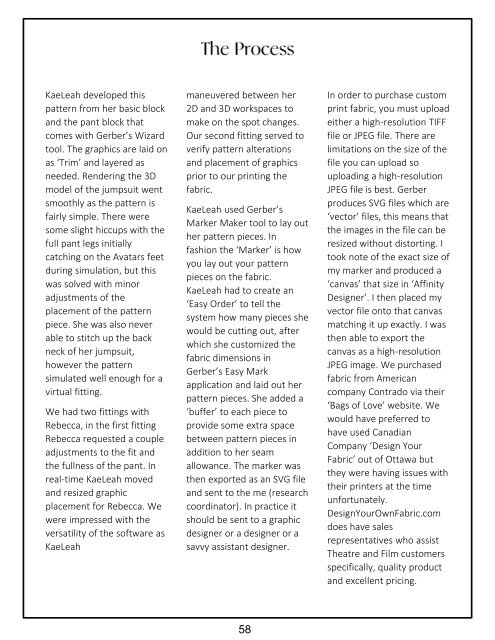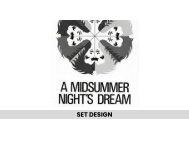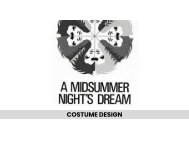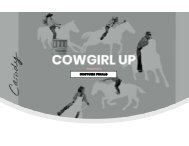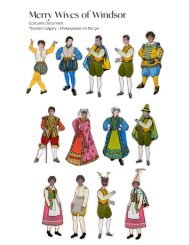Canadian Costumer's Digital Research Initiative Results
This research is targeted to Canadian Costumers, and more specifically to those working in the production of theatrical costumes.
This research is targeted to Canadian Costumers, and more specifically to those working in the production of theatrical costumes.
You also want an ePaper? Increase the reach of your titles
YUMPU automatically turns print PDFs into web optimized ePapers that Google loves.
KaeLeah developed this<br />
pattern from her basic block<br />
and the pant block that<br />
comes with Gerber’s Wizard<br />
tool. The graphics are laid on<br />
as ‘Trim’ and layered as<br />
needed. Rendering the 3D<br />
model of the jumpsuit went<br />
smoothly as the pattern is<br />
fairly simple. There were<br />
some slight hiccups with the<br />
full pant legs initially<br />
catching on the Avatars feet<br />
during simulation, but this<br />
was solved with minor<br />
adjustments of the<br />
placement of the pattern<br />
piece. She was also never<br />
able to stitch up the back<br />
neck of her jumpsuit,<br />
however the pattern<br />
simulated well enough for a<br />
virtual fitting.<br />
We had two fittings with<br />
Rebecca, in the first fitting<br />
Rebecca requested a couple<br />
adjustments to the fit and<br />
the fullness of the pant. In<br />
real-time KaeLeah moved<br />
and resized graphic<br />
placement for Rebecca. We<br />
were impressed with the<br />
versatility of the software as<br />
KaeLeah<br />
maneuvered between her<br />
2D and 3D workspaces to<br />
make on the spot changes.<br />
Our second fitting served to<br />
verify pattern alterations<br />
and placement of graphics<br />
prior to our printing the<br />
fabric.<br />
KaeLeah used Gerber’s<br />
Marker Maker tool to lay out<br />
her pattern pieces. In<br />
fashion the ‘Marker’ is how<br />
you lay out your pattern<br />
pieces on the fabric.<br />
KaeLeah had to create an<br />
‘Easy Order’ to tell the<br />
system how many pieces she<br />
would be cutting out, after<br />
which she customized the<br />
fabric dimensions in<br />
Gerber’s Easy Mark<br />
application and laid out her<br />
pattern pieces. She added a<br />
‘buffer’ to each piece to<br />
provide some extra space<br />
between pattern pieces in<br />
addition to her seam<br />
allowance. The marker was<br />
then exported as an SVG file<br />
and sent to the me (research<br />
coordinator). In practice it<br />
should be sent to a graphic<br />
designer or a designer or a<br />
savvy assistant designer.<br />
In order to purchase custom<br />
print fabric, you must upload<br />
either a high-resolution TIFF<br />
file or JPEG file. There are<br />
limitations on the size of the<br />
file you can upload so<br />
uploading a high-resolution<br />
JPEG file is best. Gerber<br />
produces SVG files which are<br />
‘vector’ files, this means that<br />
the images in the file can be<br />
resized without distorting. I<br />
took note of the exact size of<br />
my marker and produced a<br />
‘canvas’ that size in ‘Affinity<br />
Designer’. I then placed my<br />
vector file onto that canvas<br />
matching it up exactly. I was<br />
then able to export the<br />
canvas as a high-resolution<br />
JPEG image. We purchased<br />
fabric from American<br />
company Contrado via their<br />
‘Bags of Love’ website. We<br />
would have preferred to<br />
have used <strong>Canadian</strong><br />
Company ‘Design Your<br />
Fabric’ out of Ottawa but<br />
they were having issues with<br />
their printers at the time<br />
unfortunately.<br />
DesignYourOwnFabric.com<br />
does have sales<br />
representatives who assist<br />
Theatre and Film customers<br />
specifically, quality product<br />
and excellent pricing.<br />
58


